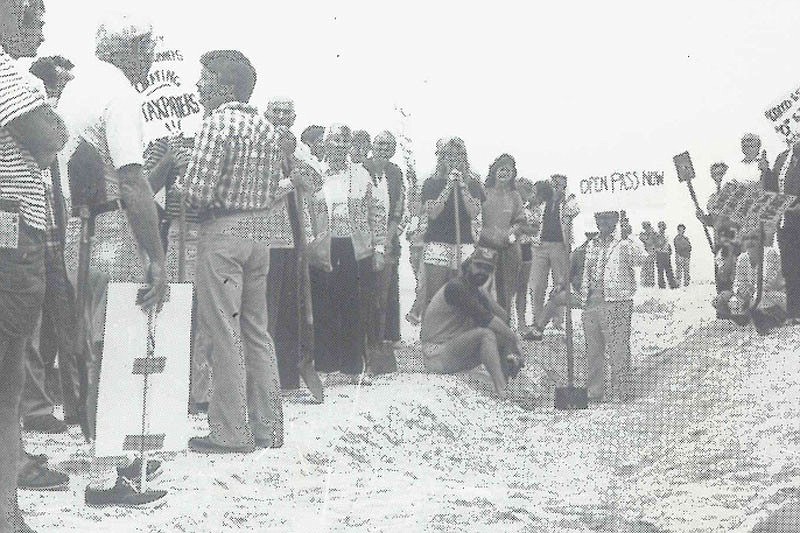- April 16, 2024
-
-
Loading

Loading

Jim Herbert doesn’t remember the year he decided to challenge a federal law — it was some time in the early 1990s.
He does, however, remember the phone call with fellow Midnight Pass Society member Bob Waechter that would lead to a group of more than 100 people digging a 10-foot-deep trench to open an inlet between Siesta Key and Casey Key.
They wanted to re-open Midnight Pass, which had been closed by a combination of natural forces and the work of property owners who wanted to protect their homes from erosion.
In 1983, Sarasota County and the Florida Department of Environmental Protection had allowed resident Syd Solomon to pay for a bulldozer to close the inlet.
That closed off a route for boaters to reach the Gulf of Mexico and a way for Mother Nature to flush Sarasota Bay. The society and local marine biologists claimed it was environmentally and commercially harmful.
Waechter and Herbert started making phone calls after deciding the tides in Sarasota Bay were perfect for a late-night shovel brigade. It would be similar but, with more stealth than the first dig in 1984.
Herbert dropped his wife off near Midnight Pass with shovels after the couple had dinner with fellow society members. He parked at Turtle Beach and walked south, but didn’t see any activity on his trek to the site at about 9 p.m.
“At first, I was really ticked,” Herbert said.
But, after walking over a sand dune near the site, he spotted more than 75 people digging a trench between the Gulf of Mexico and Sarasota Bay.
“Everyone was quiet,” Herbert recalls. “It was all business — there wasn’t a drink in sight.”
Sarasota County Commissioner Nora Patterson, who also participated in the first dig, disputes the latter claim.
“I clearly remember there has was beer involved,” Patterson said with a laugh. The trench did fill with seawater, she recalled.
“It did suggest that there were a lot of people who care,” Patterson said.
Comrades of the cause to open Midnight Pass arrived by foot and by boat throughout the night, Herbert said.
“It was an interesting time, because the conservationists had the net ban passed and they were mortal enemies of the commercial fishermen,” Herbert said. “But, they were digging in the trenches together.”
The group placed a makeshift cork to hold bay water back while they dug the trench, which Herbert recalled being as deep as 10 feet. A little after midnight, commercial fisherman, eager to let the pass flow, convinced the group to pull the plug, and the inlet was reborn.
County officials arrived the following rainy morning, as did Herbert, and looked for the tracks of the bulldozer suspected of the illegal earth-moving project.
Tuesday, Nov. 13, U.S District Judge Elizabeth Kovachevich set the trial for a lawsuit re-filed by the society this summer against the Florida Department of Environmental Protection and Sarasota County.
In the society’s current suit, it alleges the DEP capriciously denied a permit to open Midnight Pass in 1991 and arbitrarily issued a notice of intent that it would deny another request in 2008.
If the plaintiffs win the suit, the court will order the DEP to issue a permit, so a contractor can use effective machinery to open Midnight Pass.
The trial is set for Nov. 6, 2014, which is 30 years after the initial, and highly publicized, “shovel brigade.”
“Politics surely played a role in keeping Midnight Pass closed all these years,” said Mote Marine Laboratory senior scientist Jim Culter, who studied conditions in Sarasota Bay during the fiery years of debate.
Culter cited Blind Pass, which separates Captiva Island and Sanibel Island, as an example of a similar situation with different results.
Tropical Storm Gabrielle closed the inlet in 2001, and Lee County had all the permits in place to re-open it by 2008, which was completed two years later.
But, the DEP had already developed a dredging program to maintain Blind Pass, so opening the closed inlet was considered an act of maintenance.
The number of cars branded with fading “Midnight Pass — Let It Flow” stickers has declined on Siesta, and the society no longer meets or collects dues, Herbert said.
The prospect of a trial date doesn’t rouse the excitement it may have in the past.
“I think people are just discouraged,” Herbert said.
And, after 30 years, the swath of land, which serves nesting sea turtles and sea birds, has evolved into a different kind of habitat.
The argument about opening the pass is now more complex, and proponents of dredging the former inlet must now consider the displacement of critters — which increase with time — in the new environment in contrast with those that were wiped out when the pass was closed in 1983.
Seagrass beds that house and feed Sarasota Bay fish and mammals died as the water quality diminished, according to the lawsuit documents. And without the flush-point, fish kills increased during the summer, Culter said.
“People always try to say what’s better for the environment one way or the other, conclusively,” Culter said.
But, with rising sea levels, Culter said, “There will be an inlet there someday.”
The Midnight Pass saga
1983 — Syd Solomon closes Midnight Pass
1984 — Midnight Pass Society formed; first shovel brigade attempts to open pass
1988 — Sarasota County applies for permit to open pass
1991 — State rejects permit application
2004 — County applies again for a permit
2008 — State notifies county it will reject the application
2012 — The society re-files a lawsuit against local and state agencies involved